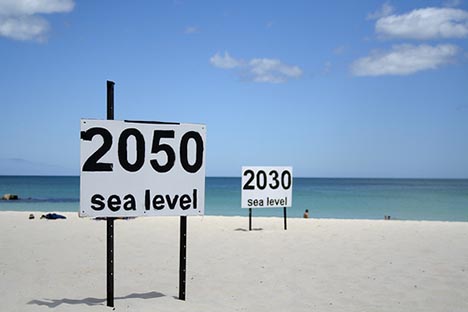December 18, 2014 – With 2015 a mere two weeks away I thought a year-in-review look at where we are trending would give humanity a sense of urgency about tackling the many challenges we are imposing on our species and the other inhabitants of this planet.
A note of caution before reading further. The 10 statistics described here are ones that most governments don’t want you to read. Nevertheless it is important that we all have a full understanding of the changes we are inflicting on the planet without a concerted international commitment to change.
- The first number is 10.9 billion. It represents the latest forecasts by the United Nations of how many of us will be living on Earth in 2100. In the past I have quoted predictions of 9.5 billion by mid-century with the growth then flattening and beginning to diminish. But the experts now are saying with birthrates not slowing down in Africa, our human presence on the planet will exceed the 10 billion number. Think of the Maslovian implications of this number.
- Output of carbon dioxide by 2100 without dramatic reductions in our use of fossil-fuel derived energy will climb from 400 to 500 parts per million or higher. Current models have carbon dioxide increasing as high as 900 parts per million if we do nothing at all. And if we dramatically reduce carbon dioxide emissions based on current output our best scenario is probably a number around 450.
- Mean average temperatures will minimally increase by 2 Celsius (3.6 Fahrenheit) degrees at best scenario carbon dioxide outcomes. But if we approach the higher value of emissions temperatures will rise more than three times that amount to 6.4 Celsius (11.5 Fahrenheit) degrees. That’s the mean average rise. In polar regions temperatures will be much higher than the mean rise. In some areas of the tropics temperatures will make areas of the planet near uninhabitable.
- For every 1 Celsius (1.8 Fahrenheit) degree our oceans warm we will witness changes to precipitation patterns and precipitation intensity. Overall a warming atmosphere by 2100 will mean average annual rainfall across the planet will increase. By 2100 the ocean’s mean average temperature may be 3 Celsius (5.4 Fahrenheit) higher than today. The implications for the creatures living in the ocean is a significant unknown. Will they adapt or will cold water species like cod and salmon vanish from the planet? What will happen to cold water zoo-plankton and phytoplankton populations that live near the top of the water column where the warmth will be greatest? What will happen to the food chain dependent on these small creatures?
- Another disturbing fact about our oceans. Ocean sea levels have risen 19 centimeters (approximately 7.5 inches) in the last century. About 40 to 50% of that is attributed to ocean expansion through warming. 35% is attributed to melting glaciers. 5% is attributed to humans pumping out groundwater sources like the Ogallala Aquifer and pouring the runoff into local watersheds where it eventually reaches the ocean. That rise is speeding up. The rate during the 20th century was 1.7 millimeters per year. Today it is 3.2 millimeters. The rise is not even decade by decade but comes in fits and starts. And it is not evenly distributed across all of the ocean surface. In some areas sea levels have risen well above the mean average, while in other areas sea levels have fallen. But at present rates by 2100 the mean average will reach as high as 98 centimeters (approximately 3 feet) and at the low end 28 centimeters (approximately 11 inches).
- A final note on changes to our oceans by 2100. Because the ocean represents the most significant carbon sink on the planet they will continue to absorb much of the carbon dioxide we put into the atmosphere. That gas when combined with water forms carbonic acid. Since the beginning of the Industrial Revolution ocean pH levels (which measure the alkalinity or acidity of a liquid) have dropped by 0.1. That means the oceans are getting more acidic. The doubling of atmospheric carbon dioxide by 2100 as described in point #3 would lower ocean pH levels by as much as 0.3. For calciferous life forms reducing pH levels will mean major disruption if not extinction. We could be saying goodbye to lobsters, crabs, clams, all other shellfish, coral, phytoplankton and zoo-plankton. Some may rapidly adapt. We can always hope!
- With changes in sea levels, precipitation and average temperatures the world in 2100 will appear far different from the one we see today. For many it will mean abandoning where they live today to find refuge. Depending on the range of scenarios we could from 200 million to 1 billion displaced. Island nations in the Pacific and Indian Ocean are most vulnerable. And populations living in areas today within a meter (3.3 feet) of current sea levels will need to find new homes. Some will adapt by building berms and dikes. Others will put homes on stilts and hope to remain where they are. And for those who will be driven away from their homes by extreme weather such as prolonged droughts, it will be a troubling future.
- To support human population our livestock demographics will also grow. Unlike the world of “Interstellar” we will not all be eating corn in 2100. Humanity will still have chickens, cattle (for both dairy and meat), goats, sheep, pigs, camels and other ruminants as food sources. Today the world chicken population is 19 billion. We raise 1.4 billion cattle and a billion sheep and pigs. That’s for a population of just over 7 billion. To support 10.9 billion all of those numbers will either proportionately grow or much of humanity will be altering its dietary habits by the time we reach 2100. Of course we may all be eating insects or in vitro meat by then.
- And speaking of food, a warming atmosphere, altered precipitation and human population growth will put new stresses on food production, particularly cereal crops, the largest contributor to the dietary needs of much of the planet. In Sub-Saharan Africa where the population bomb represents the greatest challenge, climate changes will reduce cereal crop yields dramatically, some researchers say by as much as 30%. That means more land will have to be cultivated to make up for the yield decline. Much of the new land will come through deforestation practices which will further reduce the natural carbon sink that forests provide. Whereas today we have between 800 million and 1 billion undernourished on the planet. By 2100 that number could triple. That’s more than the total number of human beings that were living on our planet in 1960 and all of them will be going to bed hungry at night.
- Our final point looks at how all of the above will contribute to the health of humanity. Malnutrition is only one outcome we can foresee in 2100. The other reflects how warming and altered precipitation patterns will change disease vectors for both human and animal populations. For example the warming of the Canadian Arctic is allowing intestinal worms to infect muskoxen leading to a rapid decline in the population. Similarly human diseases are migrating poleward. Borne by insects like mosquitoes as breeding grounds expand, a number of diseases are appearing or reappearing in areas where they have not been seen. Among these are Dengue fever, Malaria, Chagas, Lupus, Encephalitis and others are finding new populations to infect at higher latitudes. How countries respond on behalf of their populations will be determined by their health infrastructure. But the climate changes we have described will put considerable stress on them as they attempt to deal with the onset of diseases that could be as disruptive as the recent outbreak of Ebola in West Africa. Where today it is estimated that 160,000 die each year from diseases resulting from climate change, that number will more than double by 2020. And by 2100 the number could be in the millions.














